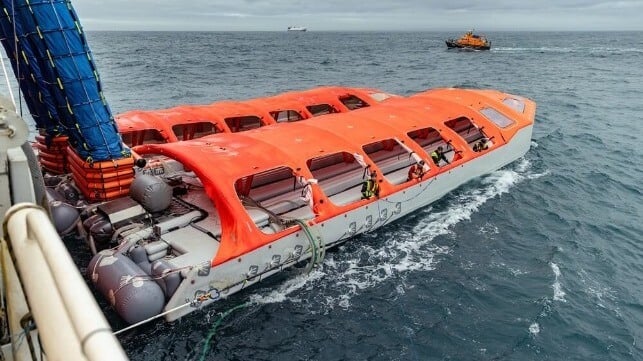Seahaven: Redefining Cruise Ship Safety and Unlocking Revenue Potential

In an era where safety, efficiency, and commercial viability define the cruise industry's trajectory, Survitec's Seahaven system emerges as a groundbreaking innovation. The world's largest inflatable lifeboat, Seahaven, is setting new benchmarks in passenger safety, vessel optimisation, and operational effectiveness.
The Future of Cruise Ship Safety and Efficiency
Cruise ship design has long been constrained by the bulk and complexity of traditional davit-launched lifeboats. While these lifeboats fulfil regulatory safety requirements, they often limit vessel design flexibility and consume valuable deck space that could be better utilised for passenger accommodations and entertainment. Enter Seahaven—a fully automated evacuation system that ensures unparalleled safety compliance and enables cruise operators to rethink how they use space aboard their vessels.
Survitec’s white paper, "Seahaven Application Study," delves deeply into the impact of integrating this revolutionary lifeboat system into modern cruise ship designs. Conducted by the naval architect firm Foreship, the study evaluates four primary configurations for implementing Seahaven, assessing its ability to enhance vessel layout, optimise weight distribution, and improve operational efficiency.
Transforming Ship Design: More Space, More Revenue
One of Seahaven's most significant advantages is its ability to free up deck space. Unlike traditional lifeboat systems, which require extensive vertical and longitudinal space, Seahaven's compact design minimises bridge overhang and enhances visibility. This feature is particularly beneficial for vessels navigating constrained waterways such as the Panama Canal.
For shipowners, the repurposing of space enabled by Seahaven presents lucrative opportunities. With bulky davit-launched lifeboats removed, operators can introduce additional balcony cabins, extend entertainment areas, or incorporate new leisure facilities—all of which enhance the guest experience and generate additional revenue. For medium-sized cruise ships, the transformation could mean converting interior cabins into sought-after balcony staterooms. At the same time, larger vessels could utilise the space savings to redesign public areas and incorporate innovative onboard attractions.
Safety and Compliance: Meeting the Highest Standards
Beyond the commercial advantages, Seahaven represents a significant leap forward in maritime safety. With the capacity to evacuate up to 1,060 passengers in under 22 minutes, this system eliminates the complexities of traditional davit and release-hook mechanisms. It has undergone extensive heavy-weather sea trials, successfully operating in conditions exceeding Beaufort Scale 6, reinforcing its reliability under real-world emergency scenarios.
In addition, Seahaven aligns seamlessly with SOLAS (Safety of Life at Sea) regulations. The system has been tested for deployment on vessels with up to a 20-degree heel, ensuring compliance with international safety standards. The white paper presents a detailed capacity analysis confirming Seahaven’s suitability for various ship sizes, demonstrating its adaptability and effectiveness across different cruise vessels.
Reducing Operational Costs and Streamlining Crew Training
Seahaven improves ship design and streamlines operational processes. Traditional lifeboat systems require extensive maintenance, regular inspections, and complex crew training for safe operation. By contrast, Seahaven’s automated deployment mechanism significantly reduces maintenance costs and minimises the need for intensive crew training. This translates to lower long-term operational expenses and enhanced safety assurance.
“Beyond delivering safety performance, Seahaven enables shipowners to optimise their fleets with improved design flexibility, greater operational efficiencies, and enhanced commercial potential,” says Claude Sada, Chief Operating Officer at Survitec.
Adapting to the Evolving Needs of the Cruise Industry
The cruise industry is continuously evolving, with an increasing emphasis on safety, sustainability, and guest experience. Since achieving Lloyd’s Register type approval in 2022, Seahaven has gained traction among shipbuilders and operators seeking to future-proof their fleets. As regulations become more stringent and passengers demand more luxurious onboard experiences, Seahaven represents a smart investment in both compliance and competitiveness.
The study also highlights Seahaven's adaptability across multiple deployment configurations, including hybrid solutions that integrate Marine Evacuation Systems (MES) and tender lifeboats. This level of flexibility enables cruise operators to tailor their safety solutions while maintaining operational efficiency.
Conclusion: The Time to Act is Now
Seahaven offers an unprecedented opportunity for shipowners and operators looking to stay ahead in an increasingly competitive and regulated industry. By enhancing safety, unlocking additional revenue potential, and improving operational efficiency, this innovative system is paving the way for the future of cruise ship design.
Download the white paper today to explore the full findings of the Seahaven Application Study and understand how Seahaven can transform your fleet.
The opinions expressed herein are the author's and not necessarily those of The Maritime Executive.
